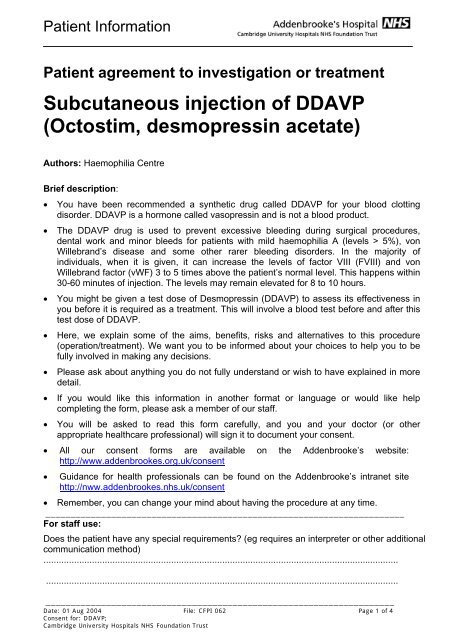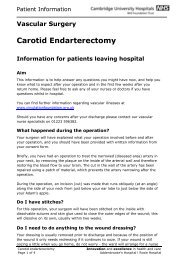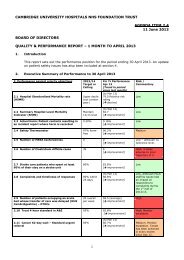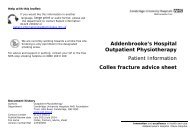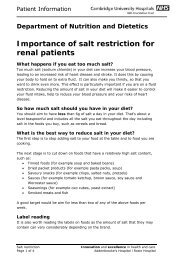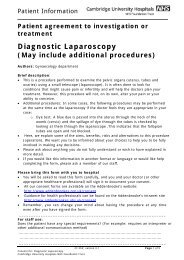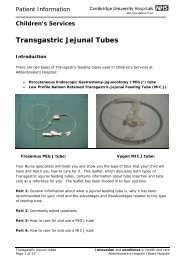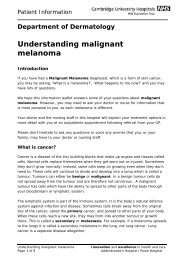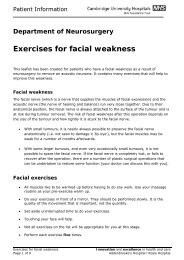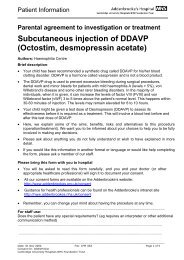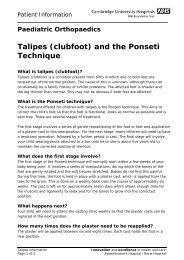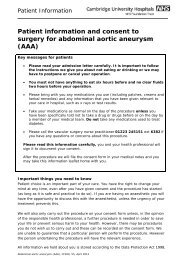Subcutaneous injection of DDAVP (Octostim, desmopressin acetate)
Subcutaneous injection of DDAVP (Octostim, desmopressin acetate)
Subcutaneous injection of DDAVP (Octostim, desmopressin acetate)
You also want an ePaper? Increase the reach of your titles
YUMPU automatically turns print PDFs into web optimized ePapers that Google loves.
Patient Information<br />
Patient agreement to investigation or treatment<br />
<strong>Subcutaneous</strong> <strong>injection</strong> <strong>of</strong> <strong>DDAVP</strong><br />
(<strong>Octostim</strong>, <strong>desmopressin</strong> <strong>acetate</strong>)<br />
Authors: Haemophilia Centre<br />
Brief description:<br />
• You have been recommended a synthetic drug called <strong>DDAVP</strong> for your blood clotting<br />
disorder. <strong>DDAVP</strong> is a hormone called vasopressin and is not a blood product.<br />
• The <strong>DDAVP</strong> drug is used to prevent excessive bleeding during surgical procedures,<br />
dental work and minor bleeds for patients with mild haemophilia A (levels > 5%), von<br />
Willebrand’s disease and some other rarer bleeding disorders. In the majority <strong>of</strong><br />
individuals, when it is given, it can increase the levels <strong>of</strong> factor VIII (FVIII) and von<br />
Willebrand factor (vWF) 3 to 5 times above the patient’s normal level. This happens within<br />
30-60 minutes <strong>of</strong> <strong>injection</strong>. The levels may remain elevated for 8 to 10 hours.<br />
• You might be given a test dose <strong>of</strong> Desmopressin (<strong>DDAVP</strong>) to assess its effectiveness in<br />
you before it is required as a treatment. This will involve a blood test before and after this<br />
test dose <strong>of</strong> <strong>DDAVP</strong>.<br />
• Here, we explain some <strong>of</strong> the aims, benefits, risks and alternatives to this procedure<br />
(operation/treatment). We want you to be informed about your choices to help you to be<br />
fully involved in making any decisions.<br />
• Please ask about anything you do not fully understand or wish to have explained in more<br />
detail.<br />
• If you would like this information in another format or language or would like help<br />
completing the form, please ask a member <strong>of</strong> our staff.<br />
• You will be asked to read this form carefully, and you and your doctor (or other<br />
appropriate healthcare pr<strong>of</strong>essional) will sign it to document your consent.<br />
• All our consent forms are available on the Addenbrooke’s website:<br />
http://www.addenbrookes.org.uk/consent<br />
• Guidance for health pr<strong>of</strong>essionals can be found on the Addenbrooke’s intranet site<br />
http://nww.addenbrookes.nhs.uk/consent<br />
• Remember, you can change your mind about having the procedure at any time.<br />
_______________________________________________________________________<br />
For staff use:<br />
Does the patient have any special requirements? (eg requires an interpreter or other additional<br />
communication method)<br />
...........................................................................................................................................<br />
..........................................................................................................................................<br />
_____________________________________________________________________<br />
Date: 01 Aug 2004 File: CFPI 062 Page 1 <strong>of</strong> 4<br />
Consent for: <strong>DDAVP</strong>;<br />
Cambridge University Hospitals NHS Foundation Trust
Patient Information Addenbrooke’s Hospital<br />
About <strong>DDAVP</strong><br />
Before taking <strong>DDAVP</strong> we will take special precautions with patients who:<br />
• Are over 65 years unless otherwise fit and healthy<br />
• Have a past history <strong>of</strong> vascular disease, myocardial infarction, high blood pressure or<br />
stroke.<br />
• Have type 2 von Willebrand unless a trial <strong>of</strong> therapy has proved it to be effective<br />
(especially type 2B).<br />
Before your procedure<br />
• When you arrive for the procedure, we shall ask you for details <strong>of</strong> your medical history<br />
and carry out any necessary clinical examinations and investigations. This is a good<br />
opportunity for you to ask us any questions about the procedure, but please feel free to<br />
discuss any concerns you might have at any time.<br />
• You will be asked if you are taking any tablets or other types <strong>of</strong> medication - these<br />
might be ones prescribed by a doctor or bought over the counter in a health food shop.<br />
It helps us if you bring details with you <strong>of</strong> anything you are taking (eg bring the<br />
packaging with you). Some anti-depressants, chlorpromazine and carbamazepine may<br />
increase fluid retention.<br />
During the procedure itself<br />
• <strong>DDAVP</strong> may be given subcutaneously (under the skin), intravenously (into a vein) or<br />
intranasally (inhaled with a metered spray in to the nostril). Usually only one dose is<br />
given. A repeat dose may be given to adults 12 to 24 hours later if required. If there is<br />
not an adequate response to <strong>DDAVP</strong> we may need to administer an intravenous<br />
plasma derived or recombinant clotting factor.<br />
After the procedure (operation/treatment)<br />
• Do not drink more fluid than you would normally (adults 1.5 to 2 litres a day).<br />
Intended benefits <strong>of</strong> the procedure<br />
• The treatment <strong>of</strong> bleeding episodes in mild and moderate haemophilia.<br />
• The normalisation or enhancement <strong>of</strong> clotting during operative procedures.<br />
Who will perform my procedure?<br />
• This procedure will be performed by a Haemophilia nurse or by the ward nursing staff.<br />
Alternative procedures that are available<br />
• Other treatments can be given such as Antifibrinolytic product eg tranexamic acid,<br />
plasma derived /recombinant clotting factor, blood Tx or FFP. These will be discussed<br />
with you before the procedure.<br />
Serious or frequently occurring risks<br />
• Fluid retention with hyponatraemia (low salt) leading to convulsions.<br />
• Headache and facial flushing.<br />
• Transient fall in blood pressure.<br />
• Stomach pains and nausea.<br />
Date: 01 Aug 2004 File: CFPI 062 Page 2 <strong>of</strong> 4<br />
Consent for: <strong>DDAVP</strong>;<br />
Cambridge University Hospitals NHS Foundation Trust
Patient Information Addenbrooke’s Hospital<br />
Information and support<br />
• You might be given some additional patient information before or after the procedure<br />
eg leaflets that explain what to do after the procedure and what problems to look out<br />
for. If you have any questions or anxieties, please feel free to ask a member <strong>of</strong> staff<br />
including the Haemophilia Nurse Specialists.<br />
• Haemophilia Centre Telephone 01223 257039 (Mon to Fri 8.30am to 4.30pm).<br />
• Haemophilia Society – www.haemophilia.org.uk.<br />
This document is also available in other languages, large print and audio format upon<br />
request – 01223 216032<br />
Cantonese<br />
Gujarati<br />
Italian<br />
Kurdish<br />
Urdu<br />
Date: 01 Aug 2004 File: CFPI 062 Page 3 <strong>of</strong> 4<br />
Consent for: <strong>DDAVP</strong>;<br />
Cambridge University Hospitals NHS Foundation Trust
Addenbrooke’s Hospital<br />
Date: 16 May 2005 File: CFPI 062 Page 4 <strong>of</strong> 4<br />
Consent for: <strong>DDAVP</strong>;<br />
Cambridge University Hospitals NHS Foundation Trust
Consent form 1<br />
Patient agreement to<br />
investigation or treatment<br />
Addenbrooke’s Hospital<br />
For staff use only:<br />
Surname:<br />
First names:<br />
Date <strong>of</strong> birth:<br />
Hospital no:<br />
Male/Female:<br />
(Use hospital identification label)<br />
Responsible health pr<strong>of</strong>essional/job title<br />
......................................................<br />
Special requirements ................................................................................................<br />
(eg other language/other communication method)<br />
Name <strong>of</strong> proposed procedure or course <strong>of</strong> treatment<br />
<strong>Subcutaneous</strong> <strong>injection</strong> <strong>of</strong> <strong>DDAVP</strong> (<strong>Octostim</strong>, <strong>desmopressin</strong> <strong>acetate</strong>)<br />
Statement <strong>of</strong> health pr<strong>of</strong>essional<br />
(To be filled in by a health pr<strong>of</strong>essional with an appropriate knowledge <strong>of</strong> the proposed<br />
procedure, as specified in the Hospital’s consent policy)<br />
I have explained the procedure to the patient. In particular, I have explained:<br />
• How it will be performed<br />
• The intended benefits <strong>of</strong> the procedure<br />
• Any serious or frequently occurring risks including those specific to the patient ..……………<br />
......................................................................................................................................................................<br />
• Any extra procedures that might become necessary during the procedure<br />
Blood transfusion<br />
Other procedure (please specify) ...............................................................................<br />
......................................................................................................................................................................<br />
I have discussed what the treatment / procedure is likely to involve, the benefits and risks <strong>of</strong> any<br />
available alternative treatments (including no treatment) and any particular concerns <strong>of</strong> this patient.<br />
• The following information leaflet has been provided: .....................................................<br />
..................................................... Version/Date/Ref:....................................................<br />
Health pr<strong>of</strong>essional’s signature .................................... Date: ..............................<br />
Name (PRINT):.......................................................... Job title:.......................................<br />
Contact details (if patient wishes to discuss details later) .....................................................<br />
I have <strong>of</strong>fered the patient information about the procedure but s/he has declined information.<br />
Important notes: (tick if applicable)<br />
The patient has withdrawn consent (ask patient to sign/date here) .................................<br />
See also advance directive/living will (eg Jehovah’s Witness form)<br />
Statement <strong>of</strong> the interpreter (if appropriate)<br />
I have interpreted the information to the best <strong>of</strong> my ability, and in a way in which I believe<br />
s/he can understand:<br />
Interpreter’s signature.......................................................... Date: ..............................<br />
Name (PRINT):....................................................................<br />
Copy accepted by patient: yes / no (please circle)<br />
Date: 16 May 2005<br />
Consent for: <strong>DDAVP</strong>;<br />
File: CFPI 062 Page 5 <strong>of</strong> 4<br />
Cambridge University Hospitals NHS Foundation Trust
Addenbrooke’s Hospital<br />
For staff use only:<br />
Surname:<br />
First names:<br />
Date <strong>of</strong> birth:<br />
Hospital no:<br />
Male/Female:<br />
Statement <strong>of</strong> patient<br />
(Use hospital identification label)<br />
Please read this form carefully. If your treatment has been planned in advance, you should already<br />
have your own copy, which described the benefits and risks <strong>of</strong> the proposed treatment. If not, you<br />
will be <strong>of</strong>fered a copy now. Do ask if you have any further questions. The staff at Addenbrooke’s<br />
are here to help you. You have the right to change your mind at any time before the<br />
procedure is undertaken, including after you have signed this form.<br />
Training doctors and other health pr<strong>of</strong>essionals is essential to the continuation <strong>of</strong> the Health<br />
Service and improving the quality <strong>of</strong> care. Your treatment may provide an important opportunity<br />
for such training, where necessary under the careful supervision <strong>of</strong> a senior doctor. You may,<br />
however, decline to be involved in the formal training <strong>of</strong> medical and other students without this<br />
adversely affecting your care and treatment.<br />
Please tick boxes to indicate you understand and either agree/disagree to the statements below.<br />
Yes No<br />
I agree to the procedure (or course <strong>of</strong> treatment) described on this form.<br />
I understand that you cannot give me a guarantee that a particular person will perform the<br />
procedure. The person will, however, have appropriate experience.<br />
I agree that any tissue (including blood) removed as part <strong>of</strong> the procedure or treatment<br />
may be used for diagnosis and audit, stored or disposed <strong>of</strong> as appropriate and in a manner<br />
regulated by appropriate, ethical, legal and pr<strong>of</strong>essional standards.<br />
I agree that tissue (including blood) not needed for my own diagnosis or treatment can be<br />
used for the following purposes that could benefit other patients.<br />
Teaching<br />
Research which may include genetic research<br />
I understand that all research will be approved by a research ethics committee and<br />
undertaken in accordance with appropriate ethical, legal and pr<strong>of</strong>essional standards.<br />
I understand that the research may be conducted within a hospital, university, not for<br />
pr<strong>of</strong>it organisation or a company laboratory.<br />
I understand that any procedure in addition to those described on this form will only be<br />
carried out if it is necessary to save my life or to prevent serious harm to my health.<br />
I have been told about additional procedures which may become necessary during my<br />
treatment. I have listed below any procedures that I do not wish, without further<br />
discussion, to be carried out.<br />
..................................................................................................................<br />
..................................................................................................................<br />
Patient’s own signature: ......................................... Date: ..........................<br />
Name (PRINT):...............................................................................<br />
If the patient is unable to sign but has indicated his/her consent, a witness should sign<br />
below. Young people may also like a parent to sign here (see guidance notes).<br />
Witness’s own signature:........................................ Date: ..........................<br />
Name (PRINT):...............................................................................<br />
Confirmation <strong>of</strong> consent (to be completed by a health pr<strong>of</strong>essional when the patient is<br />
admitted for the procedure, if the patient has signed the form in advance)<br />
On behalf <strong>of</strong> the team treating the patient, I have confirmed with the patient that s/he<br />
has no further questions and wishes the procedure to go ahead.<br />
Signature: . ................................................................... Date: ...................................<br />
Name (PRINT): .........................................................................Job Title:............................................<br />
Date: 16 May 2005<br />
Consent for: <strong>DDAVP</strong>;<br />
File: CFPI 062 Page 6 <strong>of</strong> 4<br />
Cambridge University Hospitals NHS Foundation Trust


